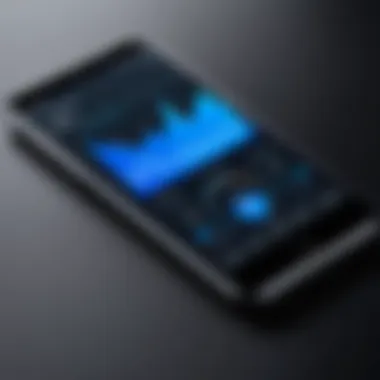Exploring Bluetooth Audio Recording: A Detailed Overview


Intro
Bluetooth audio recording has emerged as a significant technology within the sound capture domain, particularly relevant for information technology professionals and industry practitioners alike. This article aims to dissect the components of Bluetooth audio recording, examining its operational principles, real-world applications, and potential impacts on various sectors.
The core of Bluetooth audio recording technology lies in its ability to transmit sound data wirelessly, thus eliminating the need for physical connections. This has evolved from simple audio playback to a comprehensive ecosystem that allows precise audio capture. As IT professionals and tech enthusiasts, understanding this evolution is crucial for evaluating tools and workflows that can integrate Bluetooth technology effectively.
In the coming sections, a detailed exploration of key features, technical specifications, and performance metrics will be conducted. Insights from benchmark tests and real-world usage scenarios will provide context on how this technology manifests in everyday applications. The analysis also aims to illuminate both the challenges and best practices, addressing how these factors can inform future decisions regarding technology adoption in professional settings.
Preface to Bluetooth Audio Recording
Bluetooth audio recording represents an increasingly relevant aspect of modern audio technology. In an age where mobility and convenience are paramount, the ability to record high-quality audio wirelessly has numerous applications in various fields, such as podcasting, content creation, and telecommunications. This section serves as an introduction to the concept and importance of Bluetooth audio recording, offering insights into its definition and historical development.
Definition and Overview
Bluetooth audio recording refers to the process of capturing sound without the need for physical cables connecting the recording device to the audio source. Bluetooth technology allows for seamless audio transmission through radio waves, making it possible to connect devices such as microphones, audio interfaces, and smartphones effortlessly. This technology supports numerous audio codecs, ensuring that various sound qualities can be achieved depending on the application's demands.
The primary benefit of Bluetooth audio recording lies in its flexibility. Users can move about freely while capturing audio, whether during interviews, dynamic recording sessions, or remote audio documentation. This mobility can drastically enhance productivity and creativity in audio projects. Furthermore, the accessibility of Bluetooth-enabled devices fosters a democratization of audio recording, allowing more individuals to engage in creating content without needing extensive setups.
Evolution of Bluetooth Technology
The development of Bluetooth technology has come a long way since its inception in 1994. The initial purpose was to provide a wireless replacement for RS-232 cables, paving the way for various applications such as file sharing, internet browsing, and audio transmission. Over the years, the technology has evolved significantly, with major iterations that have improved connection speed, range, and overall stability.
The introduction of Bluetooth 2.0 in 2004 marked a significant leap, allowing for Enhanced Data Rate (EDR) which improved bandwidth up to 3 Mbps. Moving forward, Bluetooth 4.0, released in 2010, brought about notable advancements, specifically with low energy (BLE) capabilities designed to conserve battery life while maintaining a reliable connection. This became particularly crucial for audio recording, where extended recording periods often tax battery power.
In more recent developments, Bluetooth 5.0 has expanded the range and data throughput, reaching distances of up to 240 meters and doubling the data capacity to 2 Mbps. Such enhancements have greatly influenced the applicability of Bluetooth in professional audio recording, making it easier to maintain high-quality audio while distancing the recording device from the source.
"Bluetooth audio technology is not merely about wireless connectivity. It's an evolving journey that adapts to user needs in various contexts."
The interplay between the evolution of Bluetooth technology and audio recording capabilities continues to shape how audio professionals approach their craft. As we delve deeper into this analysis, we will explore the technical underpinnings and implications of these advancements on device compatibility, performance, and practical applications in various industries.
Technical Underpinnings of Bluetooth Audio Recording
Understanding the technical underpinnings of Bluetooth audio recording is crucial for anyone involved in this space. It involves examining how Bluetooth technology enables wireless audio transmission and the various elements that influence performance. This section discusses Bluetooth protocols and audio codecs, addressing their significance in delivering high-quality audio recordings.
Bluetooth Protocols Explained
Bluetooth technology operates using protocols, which are a set of standardized rules governing data transmission. The most relevant protocol for audio recording is the Bluetooth Audio/Video Remote Control Profile (AVRCP) and Audio Streaming for Bluetooth (A2DP). A2DP allows for high-quality audio streaming between devices, essential in recording applications.
The evolution of these protocols has enhanced the reliability and efficiency of audio transmission. Newer versions, like Bluetooth 5.0, offer improvements in range, data transfer speeds, and connectivity. These advancements are vital for professionals who require stable, high-quality audio for recording. The low latency characteristic of Bluetooth can significantly enhance user experience, particularly in activities such as podcasting or live streaming.
In addition, devices using Bluetooth Low Energy (BLE) can maintain audio connectivity with minimal power consumption. This feature is particularly important for portable audio recording devices, as it extends battery life without compromising audio quality. Understanding the specific protocols in use is essential for IT professionals and tech enthusiasts, as this knowledge directly impacts user experience and device performance.
Audio Codecs and Their Importance
Audio codecs play a pivotal role in Bluetooth audio recording, impacting the quality and efficiency of sound transmission. A codec is an algorithm that compresses and decompresses audio data to facilitate smoother transmission over Bluetooth. The selection of an appropriate codec can significantly alter the sound output.
Common Bluetooth audio codecs include SBC, AAC, aptX, and LDAC. Each codec has unique characteristics:
- SBC (Subband Coding): Widely supported but offers lower sound quality compared to others.
- AAC (Advanced Audio Codec): Common in Apple devices; often delivers better audio quality than SBC.
- aptX: Offers reduced latency and higher bitrate, suitable for professional applications requiring near CD quality.
- LDAC: Developed by Sony, enables high-resolution audio streaming over Bluetooth.
Choosing the right codec is vital for optimal audio clarity and overall performance. Not every device supports all codecs, and the optimal codec may vary based on the recording scenario and intended use. For instance, podcast creators may prioritize low latency, while musicians might seek out higher fidelity.
Audio codecs not only influence recording quality but also affect data transfer efficiency. An understanding of these codecs is essential for IT professionals who aim to integrate Bluetooth audio recording into their systems effectively.
Device Compatibility and Requirements


When considering Bluetooth audio recording, the concept of device compatibility and requirements becomes paramount. This includes ensuring that the recording devices, playback systems, and any intermediary technology function cohesively. Device compatibility not only affects the quality of the recording but also influences user experience and overall system performance.
The essential aspects of this topic involve identifying the types of audio recording devices available, their compatibility with other devices such as smartphones and wearables, and the specific requirements needed for optimal performance.
Audio Recording Devices
Bluetooth audio recording is employed in various devices. These include standalone microphones, audio interfaces, and digital recorders, all equipped with Bluetooth capabilities. The advent of Bluetooth 5.0 has significantly enhanced the performance of these devices. They now offer improved audio quality and extended range, which are crucial for reliable recordings.
Some factors to consider when choosing an audio recording device include:
- Sample Rate and Bit Depth: Higher specifications lead to better audio fidelity, which is essential for professional recordings.
- Microphone Types: Different microphones cater to varied recording needs like interviews, music, or field recording.
- Battery Life: Extended battery life is important for long sessions, especially in professional scenarios.
Ensuring that the device can handle high-quality audio input while maintaining a strong Bluetooth connection is necessary for successful recordings.
Smartphone Integration
Smartphones play a significant role in Bluetooth audio recording. Many applications are designed to interface seamlessly with external audio devices. This includes podcasts, voice memos, or music recording apps. Integration considerations involve ensuring that the apps are compatible with the audio hardware, which can vary widely between device brands and models.
Smartphone users must verify compatibility based on:
- Operating Systems: Some audio recording applications may only function on specific operating systems, such as Android or iOS.
- Bluetooth Versions: Different smartphones support various Bluetooth versions. For instance, devices supporting Bluetooth 5.0 will have better range and connectivity than those on older standards.
- App Ecosystem: The availability of software that supports audio production can greatly enhance the functionality of smartphones in recording scenarios.
Wearable Technology Options
The rise of wearable technology has introduced new opportunities for Bluetooth audio recording. Devices such as smartwatches or fitness trackers can now incorporate audio recording capabilities. These integrate easily with smartphones for enhanced functionality. The benefits are multifold, including increased portability and the ability to record hands-free.
However, wearables come with their own set of compatibility requirements:
- Connectivity: Users must ensure wearables can connect effectively with their primary recording devices.
- Usability: The interface on these devices must be user-friendly, particularly during active situations where ease of access is critical.
- Audio Quality: While wearables offer convenience, their audio quality must meet the needs of the intended recording application.
In summary, understanding device compatibility and requirements in Bluetooth audio recording is essential for IT professionals and tech enthusiasts alike. Ensuring that recording devices seamlessly integrate with smartphones and wearables can significantly enhance audio production quality and overall user satisfaction.
Performance Metrics in Bluetooth Audio Recording
Understanding performance metrics in Bluetooth audio recording is essential for delivering high-quality audio experiences. These metrics help in assessing how well devices handle sound transmission and how effectively they can perform under various conditions. With the increasing prevalence of Bluetooth technology for audio, insights into metrics such as audio quality, latency, and connectivity range become imperative.
Audio Quality Considerations
Audio quality is a critical aspect in Bluetooth audio recording. Various factors influence this quality, including the codecs used and the transmission capabilities of both the source and the receiver. Different codecs like SBC, AAC, and aptX serve distinct purposes.
- SBC is standard but results in lower sound fidelity.
- AAC offers better performance, especially on Apple devices.
- aptX is tailored for higher quality audio, often minimizing compression.
When selecting devices, understanding their codec compatibility is essential. Devices utilizing high-fidelity codecs are likely to deliver a richer audio experience. Recording professionals must prioritize devices that meet industry standards for audio clarity and consistency.
Latency Issues and Solutions
Latency can present significant challenges in Bluetooth audio recording. It refers to the delay between the audio input and the output. This delay can affect live performances and real-time interactions, resulting in unsynchronized audio. For professionals, minimizing latency is crucial. Some solutions include:
- Opting for Low Latency Codecs: Using codecs designed for low latency can significantly enhance performance.
- Firmware Updates: Keeping device firmware current can result in improved latency rates.
- Choosing Quality Devices: Higher-end devices often have better optimization for low latency.
An example of a device that addresses latency issues is the Sony WH-1000XM4 headphones, which implement advanced audio processing to reduce lag significantly.
Range and Connectivity Stability
Range and stability are pivotal for effectively utilizing Bluetooth audio recording technology. In open areas, Bluetooth typically achieves a range of up to 100 meters, but this distance is influenced by obstacles like walls. Connectivity stability can fluctuate based on the environment and the number of devices connected.
For optimal range and stability, consider the following:


- Device Placement: Avoid physical obstacles that may interfere with the signal.
- Bluetooth Class: Devices often operate on different classes, impacting range—Class 1 devices provide the longest range.
- Firmware Maintenance: Regular updates to ensure the latest connectivity improvements.
In summary, focusing on these performance metrics helps ensure effective audio recording using Bluetooth. Investing in the right technology and understanding the impact of various parameters allows IT professionals and tech enthusiasts to make informed decisions in selecting their tools.
Applications of Bluetooth Audio Recording
The applications of Bluetooth audio recording are vast and increasingly relevant in today’s digital landscape. This technology offers flexibility and convenience, making it an attractive option across various sectors. Understanding these applications can help IT professionals and tech enthusiasts discern how Bluetooth audio recording can enhance their workflows and improve user experiences.
Content Creation and Podcasting
Bluetooth audio recording has revolutionized content creation, especially in the realm of podcasting. The ability to record high-quality audio wirelessly allows creators to work in diverse environments without being tethered to traditional recording equipment. Noteworthy advantages include portability and ease of use. Content creators can thus record interviews and discussions on-location, minimizing the logistical challenges involved in studio setups.
Using Bluetooth microphones, podcasters can achieve clear audio quality even in challenging acoustic settings. Many Bluetooth devices are compatible with smartphones and laptops, making them an accessible choice for budding podcasters.
Additionally, Bluetooth-enabled devices often support various audio codecs, enhancing audio fidelity during transmission. This ensures that podcasts are not only released quickly but also maintain a professional sound quality.
Speech Recognition Technologies
Bluetooth audio recording also plays an important role in speech recognition technologies. Various applications, from voice assistants to transcription services, depend on clear audio input. Wireless recording devices provide significant advantages in capturing speech in real time from multiple speakers without the hindrance of cables.
Accuracy in speech recognition is paramount. Hence, the quality of the microphone and the codec used to process the audio significantly impact performance. By employing high-quality Bluetooth microphones, systems can minimize background noise and focus on the primary audio source, leading to better recognition outcomes.
Furthermore, as companies increasingly integrate speech recognition technologies into customer service solutions, Bluetooth devices can facilitate fluid communication between users and AI systems, removing barriers presented by fixed setups.
Telecommunication Use Cases
In telecommunications, Bluetooth audio recording is increasingly utilized to enhance communication quality in conferences and virtual meetings. Equipped with Bluetooth headsets, participants can engage with clear audio without being confined to a desk or workstation.
Many organizations have started to embrace Bluetooth technology for remote work environments. This flexibility allows employees to move freely while still being engaged in discussions, promoting a sense of connectivity despite physical distances.
Additionally, the reliability of Bluetooth audio devices during calls can greatly impact collaboration efforts. The integration of noise cancellation features further enhances call quality, making it ideal for those in busy environments.
"Bluetooth audio recording transforms traditional communication methods by providing flexibility and enhancing clarity in discussions."
Challenges Associated with Bluetooth Audio Recording
Bluetooth audio recording technology offers convenience and flexibility, but it also faces a series of challenges that can impact performance and user satisfaction. Addressing these challenges is critical for IT professionals and tech enthusiasts who seek to maximize the efficacy of Bluetooth audio applications. Understanding these challenges means recognizing specific elements like interference, signal disruption, and battery longevity, all of which can affect the overall user experience.
Interference and Signal Disruption
Bluetooth operates in the 2.4 GHz spectrum, which is crowded with various other wireless signals, including Wi-Fi, microwave ovens, and other Bluetooth devices. This overlap can lead to interference, which may cause poor audio quality or connectivity issues during recording sessions. The physical environment also plays a crucial role; walls, furniture, and human bodies can obstruct signals, leading to further disruptions.
To mitigate these issues, it is advisable to:
- Choose devices with advanced antenna technologies that can better handle signal loss.
- Perform recordings in less congested environments whenever possible.
- Utilize Bluetooth 5.0 and higher, as these versions improve interference resistance through enhanced signal processing and longer range capabilities.
Being aware of these factors can greatly enhance recording quality and reliability, making it essential for defining effective recording setups.
”The key to successful Bluetooth recording lies in maintaining a clear signal path.”
Battery Life Constraints
Battery life is a significant concern in Bluetooth audio recording, especially for mobile and portable devices. Bluetooth connections require power both from the audio source and the connected device, leading to quicker battery drain than traditional wired connections. Factors impacting battery longevity include Bluetooth codec selection, device settings, and usage patterns.
To extend battery life during audio recording, consider the following strategies:


- Select power-efficient audio codecs like SBC or AAC.
- Adjust device settings to turn off unnecessary features and reduce sampling rates during recordings.
- Keep devices charged and use power-saving modes when available.
Understanding these battery management aspects can lead to improved usability and performance, aligning with the needs of professionals and enthusiasts alike.
Future Trends in Bluetooth Audio Recording
The evolution of Bluetooth audio recording is not just a temporary phase; it embodies ongoing advancements that can significantly influence how audio content is created, delivered, and consumed. This section will analyse the future trends that are shaping the landscape of Bluetooth audio recording and their implications for professionals in information technology and audio engineering.
Advancements in Codec Technology
Codec technology is central to audio recording over Bluetooth, as it directly impacts sound quality and the efficiency of data transmission. Recent improvements in audio codecs like AAC, aptX, and LC3 are essential for higher fidelity sound without sacrificing connectivity. These advancements reduce compression artifacts and enhance the listener experience by providing clearer and richer audio.
Moreover, the adoption of newer codecs can minimize latency, which is critical for applications such as live performances and interactive communication. Without proper codec support, even the best recording devices can falter, leading to frustrating experiences for users. For IT professionals, staying abreast of these developments ensures that they can recommend the best systems for their operational needs.
Integration with AI and Machine Learning
AI and machine learning are revolutionizing many fields, and Bluetooth audio recording is no exception. By integrating these technologies, recording devices can achieve more precise audio capture and editing solutions. For example, AI algorithms can analyse audio patterns and suggest optimal recording settings based on environmental factors, which enhances the quality even in less-than-ideal conditions.
Furthermore, machine learning can assist in automating noise reduction and audio enhancement processes during post-production stages. These capabilities allow for quick turnaround times in audio editing and may elevate the quality of content released across various platforms.
However, the implications of this integration raise considerations about privacy and data handling. As audio capture becomes increasingly nuanced, the security of user data must remain a priority. This creates an opportunity for IT professionals to engage in discussions on best practices for data protection while they leverage the benefits that AI brings to audio recording.
"The impact of AI and codec advancements in Bluetooth audio recording will not only improve audio quality but also elevate user experience to unprecedented levels."
In summary, the future holds promising advancements in codec technology and the integration of AI. Understanding these trends is crucial for IT professionals and technology enthusiasts who wish to stay relevant in an evolving industry.
Best Practices for Effective Use
Understanding how to effectively use Bluetooth audio recording is crucial for IT professionals and tech enthusiasts. This practice ensures not only high-quality audio but also a streamlined workflow. Optimal use can enhance the overall recording experience and maximize the benefits from the technology.
Selecting the Right Equipment
Choosing the correct equipment is fundamental to achieving quality results. The first step is identifying compatible devices that support the required Bluetooth protocols. Not all devices are created equal; some might offer better audio quality or lower latency than others.
Key aspects to consider include:
- Microphone Quality: Opt for microphones that provide clear audio capture. Look for specifications like frequency response and sensitivity.
- Bluetooth Version: Newer versions such as Bluetooth 5.0 or higher provide improved data rates and reduced power consumption. This can lead to better audio quality and longer recording times without interruption.
- Battery Life: Consider the battery capabilities of your devices. A longer battery life is essential for extended recording sessions.
- Brand Reputation: Brands like Rode or Shure are known for their top-quality audio devices. Research user reviews and industry feedback before making a purchase.
Optimal Settings for Recording
After selecting the appropriate equipment, settings adjustments become vital. The optimal recording settings can significantly affect the audio quality. Here are some recommendations:
- Sample Rate: A higher sample rate (e.g., 48 kHz) can provide better clarity and detail in recordings, especially for professional use.
- Bitrate: Choose higher bitrates, like 256 kbps or above, to ensure audio fidelity. This choice reduces compression artifacts and improves playback quality.
- Environmental Consideration: Ensure that the recording environment is quiet. Background noise can detract from the audio quality. Using sound dampening materials in rooms can enhance acoustics.
"Selecting the right equipment and optimizing settings are cornerstones of high-quality Bluetooth audio recording."
Utilizing these practices can lead to a remarkable improvement in your recordings. When equipped with proper tools and knowledge, individuals can produce audio that meets professional standards.
Finale
The conclusion of this article serves not only as a summary but as a reflection on the transformative impact of Bluetooth audio recording technology. It encapsulates the key insights derived from examining the technology's evolution, its applications in various fields, and the inherent challenges faced by users. Understanding Bluetooth audio recording is significant for both consumers and professionals in the tech industry. This knowledge enables informed decisions surrounding technology adoption and integration into existing systems.
Summarizing Key Insights
Throughout the exploration of Bluetooth audio recording, several crucial points emerged:
- Technological Evolution: Bluetooth technology has advanced significantly, reaching a level that supports high-quality audio transmission.
- Device Versatility: The compatibility of numerous devices with Bluetooth audio has widened its scope of use, from headphones to professional recording devices.
- Performance Metrics: Metrics such as audio quality, latency, and connectivity stability are vital for optimal performance in recording scenarios.
- Industry Applications: Various sectors, including content creation, telecommunication, and speech recognition, benefit from this technology.
- Best Practices: Selecting appropriate equipment and optimizing settings can enhance the recording experience and output quality.
These insights form the foundational knowledge necessary for both existing and future users of Bluetooth audio recording technology.
Looking Ahead: The Future of Bluetooth Audio Recording
Future developments in Bluetooth audio recording are promising. As the demand for higher audio fidelity continues to rise, advancements in codec technology will play a critical role in enhancing audio quality while maintaining efficient bandwidth use. Furthermore, the integration of AI and machine learning into audio recording processes could enable smarter, more responsive systems, capable of adapting to various recording environments.



